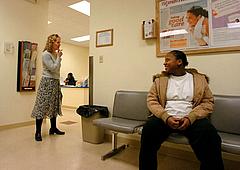State 'missing out'' on health funding
This story is Part 7 of a 15-part series that examines health care needs in Gary, Ind.
Part 1: Scary ER visits a matter of routine for staff
Part 2: Teaching hospital would fill a need in Gary, region
Part 3: Without a trauma center, NWI out of time on 'golden hour'
Part 4: ER drama offers glimpse into Gary health system
Part 5: High-tech system helps track hospital patients
Part 6: Health reform threatens funding for Methodist
Part 7: State 'missing out' on health funding
Part 8: Woman wins fight against obesity
Part 9: Diabetes 'scared me to death'
Part 10: Methodist financial turnaround 'remarkable'
Part 11: City suffers from chronic shortage of physicians
Part 12: Health-care officials rip Gary's snow response
Part 13: City's history, economic vitality chart course of residents' health
Part 14: Community health centers a safety net for urban populations

Nurse/midwife Leah Staples checks in with patient Ebony Carpenter about her blood pressure at the Gary Community Health Center in Gary.
Every dollar invested in a community health center yields returns beyond that investment, said an official of the association representing such centers in Indiana.
“Not only do we provide care to people without access to health services, but we improve the economy,” said Phil Morphew, chief executive officer of the Indiana Primary Care Association, the educational and lobbying group for 19 federally qualified community health centers and 28 state-funded health centers.
But to qualify to host a community health center, a city or town must demonstrate strong health-care needs. Gary was designated as a medically underserved area in 1993, but has been a health professional shortage area since 1978.
In its most recent designation, the federal government counted 26.5 primary care physicians in Gary serving a population of 88,788 (which may not include the entire population of Gary), or one physician serving 3,330 residents.
While that ratio is supposed to exceed one physician for every 3,500 residents in most cases, Gary’s high poverty and infant mortality rates and large senior population qualify it as a high-need community, according to Andy Jordan, Health Resources and Services Administration director of the office of shortage designation.
The primary reason for obtaining those designations, Jordan said, is the ability to recruit physicians and other primary health-care providers to hospitals, community health centers and even physician groups practicing there. The federal designation allows those providers to recruit primary care doctors and nurses from the National Health Service Corps, a federal program that allows doctors who volunteer to practice in medically underserved areas to seek repayment or forgiveness of their medical school loans.
Jordan said any not-for-profit health-care organization can apply as long as it meets the requirements, which include accepting Medicare and Medicaid funding and charging its clients on a sliding fee scale.
Another reason to apply is that the federal Centers for Medicare and Medicaid Services offers 10 percent higher Medicare bonus payments to physicians practicing in shortage areas and waives a federal immigration requirement that allows foreign physicians training in the United States to legally remain to practice in medically underserved areas for two years instead of being forced to return to their home countries after their U.S. training is completed.
State lags behind most others
“The Gary community will feel the impact of those Medicare incentive payments,” said the Indiana Primary Care Association’s Morphew. “And those loan repayments are valuable recruiting tools. Primary care providers can receive up to $60,000 in loan repayments over two years and can extend that benefit year by year up to a $100,000 loan repayment.”
He said those health centers have to meet many criteria, including being governed by a board whose members are at least 51 percent patient users, charging on a sliding fee scale and treating all patients who come in, regardless of whether they have insurance.
Morphew, who has held his post for around 18 months, said he’s concerned that Indiana community health centers could lag behind those in other states.
“Indiana ranks dead last in the nation in public health spending per capital from HRSA,” said Morphew. “We get under $13.63 per capita, compared to a state our size like Washington, which receives more $32.13 per capita. We’re missing out and I’m trying to encourage Indiana centers to apply for that money. Southern Indiana is a barren wasteland for health centers and there’s nothing from Gary to Lafayette. The need is there, but the community health centers aren’t.”
According to the not-for-profit Trust for America’s Health, Indiana ranks 48th in per capita public health spending from the U.S. Centers for Disease Control and Prevention (CDC) and per capita state funding for public health ranks 47th in the nation. The national state average for per capita HRSA spending is $24.71.
Morphew said he’s urging some of Indiana’s state funded health centers to pursue federally qualified status so they can become eligible for the federal funding “so we can begin to catch up with the rest of the country.”
